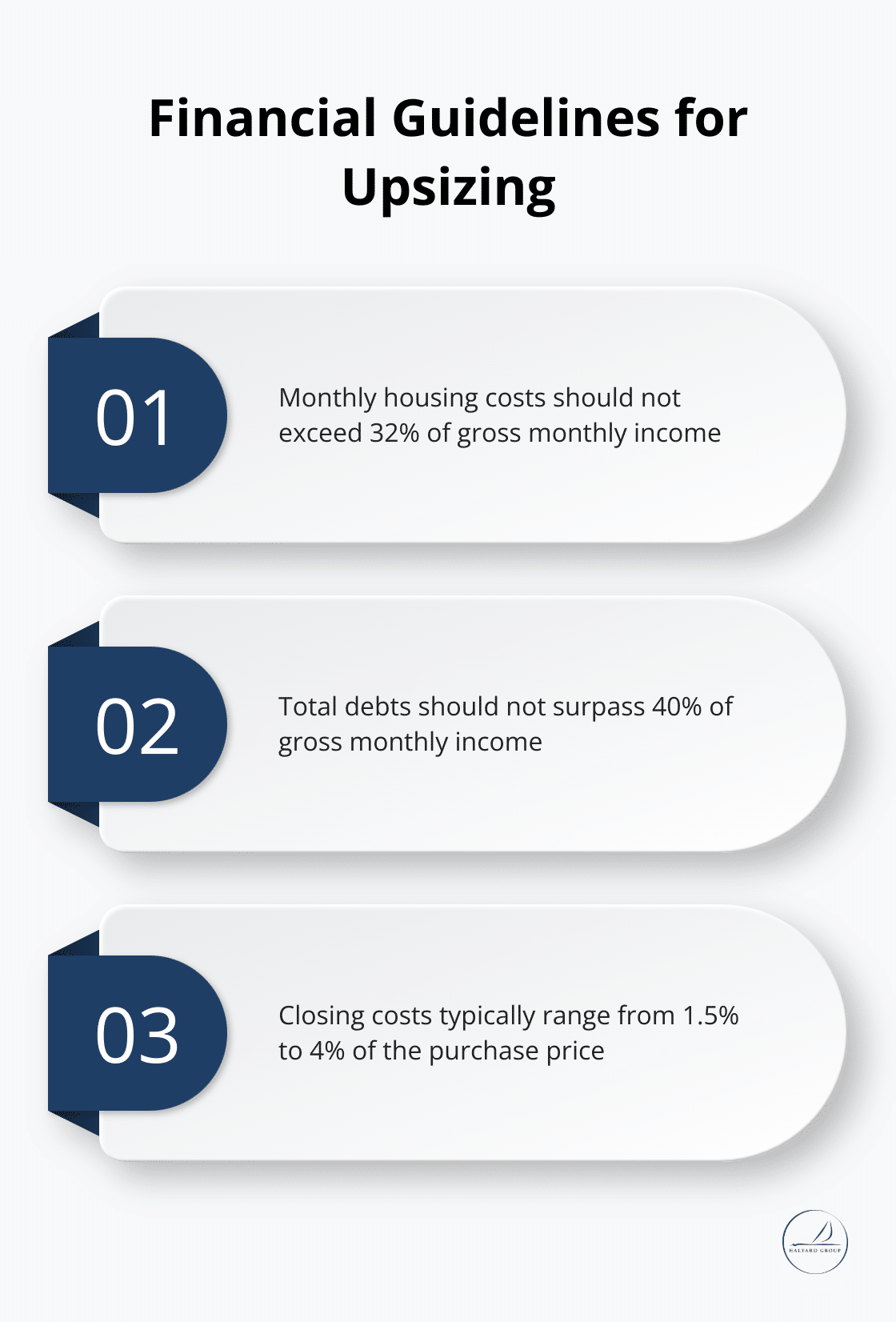Is your family feeling cramped in your current home? The decision to upsize is a significant milestone that requires careful consideration.
At The Halyard Group, we understand that determining the right upsizing timeline can be challenging. This guide will help you navigate the process, from recognizing the signs it’s time to move to understanding the financial implications and practical steps involved in finding your family’s perfect new home.
Is Your Home Bursting at the Seams?
The Great Storage Squeeze
Storage space often becomes a premium as families grow. A study by the National Association of Home Builders reveals that 25% of home buyers report the pandemic has impacted what they want in a home or community. You might need to consider upsizing if:
- Your closets overflow
- Your garage transforms into a storage unit
- You contemplate renting external storage
These signs indicate that your current home no longer accommodates your family’s belongings comfortably.

Living Room or Obstacle Course?
Living areas should provide relaxation and family bonding, not navigation challenges. Red flags include:
- Tripping over toys
- Lack of clear surfaces for work
- Family members competing for seating space
Bedroom Battles
While children sharing bedrooms can foster positive experiences, the need for personal space increases as they grow older. The National Sleep Foundation suggests that children over the age of 10 benefit significantly from having their own rooms, improving sleep quality and academic performance. Consider upsizing if your kids constantly argue over space or privacy.
The Great Outdoors (or Lack Thereof)
Outdoor space plays a crucial role in family well-being. The National Recreation and Park Association reports that spending as little as 20 minutes a day outside helps to reduce stress. You might need a larger home if:
- Your backyard feels more like a postage stamp than a play area
- You long for space to garden, entertain, or simply relax outdoors
A home with a larger lot could significantly improve your family’s quality of life.
As you reflect on these signs, you might wonder about the financial implications of upsizing. The next section will explore the important financial considerations to keep in mind when contemplating a move to a larger home.
Can You Afford to Upsize?
Assessing Your Financial Situation
Before you decide to upsize, take a close look at your finances. The Canada Mortgage and Housing Corporation (CMHC) recommends that your monthly housing costs should not exceed 32% of your gross monthly income. This includes mortgage principal and interest, taxes, heating costs, and condo fees (if applicable). When you factor in all your debts, this number should not surpass 40% of your gross monthly income. Utility and maintenance expenses often increase with a larger home… to get a clearer picture of what to expect, check out our guide on the hidden costs of upsizing your home before you commit to a purchase.

Calculating Costs of a Larger Home
The Canadian Real Estate Association regularly revises its forecast for provincial and national sales activity and average home prices. Don’t forget to account for closing costs, which typically range from 1.5% to 4% of the purchase price.
Exploring Mortgage Options
The Bank of Canada’s key interest rate influences mortgage rates, so keep an eye on economic trends. Shop around for the best rates and consider whether a fixed or variable rate mortgage suits your financial situation better.
Budgeting for Increased Expenses
Utility and maintenance expenses often increase with a larger home. The Ontario Energy Board provides estimates that can help you anticipate higher energy costs. On average, expect utility bills to increase by 20-30% when moving to a home that’s 50% larger.
Maintenance costs also rise with square footage. A general rule is to set aside 1-3% of your home’s value annually for maintenance and repairs. For a $1 million home, that’s $10,000 to $30,000 per year.

Planning for the Future
Many families successfully navigate the financial aspects of upsizing with careful planning and expert guidance. A larger home is an investment in your family’s future, but it’s essential to ensure it’s a financially sound decision.
As you consider these financial aspects, you might wonder about the practical steps involved in the upsizing process. The next section will guide you through what to expect when you decide to make the move to a larger home.
Navigating the Upsizing Journey
Pinpoint Your Family’s Needs
Start your upsizing process by creating a detailed list of must-haves for your new home. A recent survey by the National Association of Realtors found that buyers consider the number of bedrooms extremely important. Determine how many bedrooms and bathrooms you need, the ideal layout, and specific features like a home office or playroom. Consider future needs as well – you might need space for aging parents or a returning adult child.
Scout the Perfect Neighbourhood
Location plays a key role when you upsize. Research potential neighbourhoods thoroughly. Examine school ratings, crime statistics, and proximity to amenities. Visit neighbourhoods at different times of day to assess traffic patterns and community atmosphere. At The Halyard Group, we guide families through this important step by helping them explore neighbourhoods in the Greater Toronto Area that best match their lifestyle and needs.
Partner with a Family Home Expert
A real estate agent who specializes in family homes can significantly improve your upsizing experience. When selecting an agent, ask about their experience with family home transitions. Find out how many families they’ve helped upsize in the past year and what strategies they use to find homes that aren’t yet on the market. A skilled agent can provide valuable insights and potentially save you thousands of dollars.
(If you’re in the Greater Toronto Area, The Halyard Group offers personalized guidance throughout the upsizing process, ensuring you find a home that truly fits your family’s lifestyle and needs.)
Prep Your Current Home for Sale
To maximize the sale price of your current home, start by decluttering. You might want to rent a storage unit to remove excess furniture and personal items. This can make your home appear more spacious and appealing to potential buyers.
Next, focus on small repairs and upgrades. A fresh coat of paint can work wonders – neutral colours often have broad appeal. According to the National Association of Realtors, kitchen upgrades can increase happiness in the home once completed.
Don’t underestimate the power of curb appeal. A well-maintained lawn and a freshly painted front door can make a strong first impression. According to REALTOR® Magazine, homes with appealing exteriors sell for 7% more on average than comparable homes with less curb appeal.
Plan for a Smooth Transition
The upsizing process takes time and patience. Keep your family’s unique needs and long-term goals at the forefront of your decision-making process. (Working with experienced professionals can help you navigate this exciting journey more effectively.)
Final Thoughts
The decision to upsize depends on your family’s unique circumstances and long-term goals. Your upsizing timeline should account for financial readiness, lifestyle changes, and market conditions. Professional guidance can help you navigate this complex process and make informed decisions.
At The Halyard Group, we offer personalized support for families upsizing in the Greater Toronto Area. We strive to maximize your current home’s value while finding a new property that aligns with your evolving needs. Our expertise covers market trends, neighbourhood dynamics, and potential property values.
Take action with confidence once you have completed thorough research and established a clear vision for your family’s future. Upsizing is not just about more space; it’s about creating a home that supports your family’s growth and happiness for years to come. (Consider how a larger home will enhance your quality of life and provide opportunities for personal growth.)
If you’re ready to start your upsizing journey, get in touch with our team to take the first step toward a home that truly fits your family’s future.





